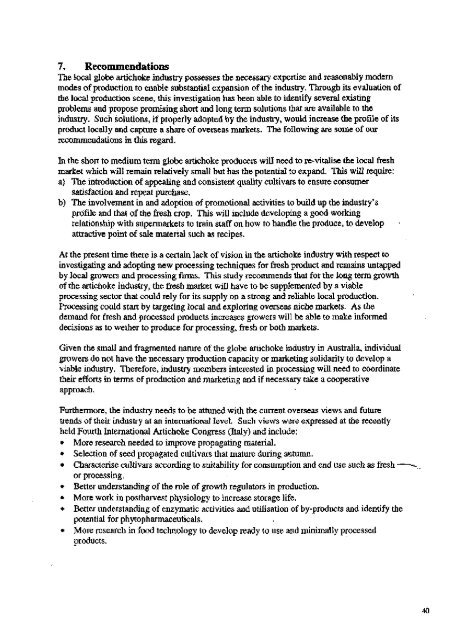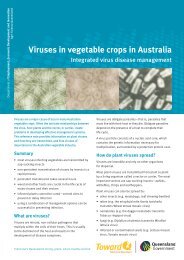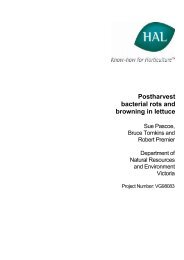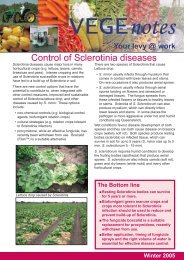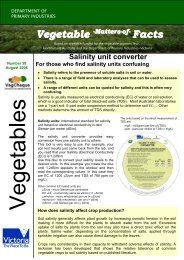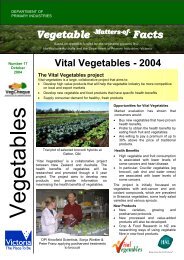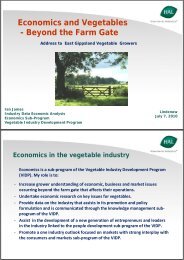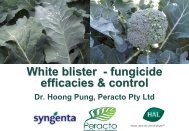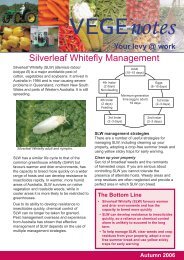Developing strategies to stimulate local consumption, export and ...
Developing strategies to stimulate local consumption, export and ...
Developing strategies to stimulate local consumption, export and ...
Create successful ePaper yourself
Turn your PDF publications into a flip-book with our unique Google optimized e-Paper software.
7. RecommendationsThe <strong>local</strong> globe artichoke industry possesses the necessary expertise <strong>and</strong> reasonably modernmodes of production <strong>to</strong> enable substantial expansion of the industry. Through its evaluation ofthe <strong>local</strong> production scene, this investigation has been able <strong>to</strong> identify several existingproblems <strong>and</strong> propose promising short <strong>and</strong> long term solutions that are available <strong>to</strong> theindustry. Such solutions, if properly adopted by the industry, would increase the profile of itsproduct <strong>local</strong>ly <strong>and</strong> capture a share of overseas markets. The following are some of ourrecommendations in this regard.In the short <strong>to</strong> medium term globe artichoke producers will need <strong>to</strong> re-vitalise the <strong>local</strong> freshmarket which will remain relatively small but has the potential <strong>to</strong> exp<strong>and</strong>. This will require:a) The introduction of appealing <strong>and</strong> consistent quality cultivars <strong>to</strong> ensure consumersatisfaction <strong>and</strong> repeat purchase.b) The involvement in <strong>and</strong> adoption of promotional activities <strong>to</strong> build up the industry'sprofile <strong>and</strong> that of the fresh crop. This will include developing a good workingrelationship with supermarkets <strong>to</strong> train staff on how <strong>to</strong> h<strong>and</strong>le the produce, <strong>to</strong> developattractive point of sale material such as recipes.At the present time there is a certain lack of vision in the artichoke industry with respect <strong>to</strong>investigating <strong>and</strong> adopting new processing techniques for fresh product <strong>and</strong> remains untappedby <strong>local</strong> growers <strong>and</strong> processing firms. This study recommends that for the long term growthof the artichoke industry, the fresh market will have <strong>to</strong> be supplemented by a viableprocessing sec<strong>to</strong>r that could rely for its supply on a strong <strong>and</strong> reliable <strong>local</strong> production.Processing could start by targeting <strong>local</strong> <strong>and</strong> exploring overseas niche markets. As thedem<strong>and</strong> for fresh <strong>and</strong> processed products increases growers will be able <strong>to</strong> make informeddecisions as <strong>to</strong> wether <strong>to</strong> produce for processing, fresh or both markets.Given the small <strong>and</strong> fragmented nature of the globe artichoke industry in Australia, individualgrowers do not have the necessary production capacity or marketing solidarity <strong>to</strong> develop aviable industry. Therefore, industry members interested in processing will need <strong>to</strong> coordinatetheir efforts in terms of production <strong>and</strong> marketing <strong>and</strong> if necessary take a cooperativeapproach.Furthermore, the industry needs <strong>to</strong> be attuned with the current overseas views <strong>and</strong> futuretrends of their industry at an international level. Such views were expressed at the recentlyheld Fourth International Artichoke Congress (Italy) <strong>and</strong> include:• More research needed <strong>to</strong> improve propagating material.• Selection of seed propagated cultivars that mature during autumn.• Characterise cultivars according <strong>to</strong> suitability for <strong>consumption</strong> <strong>and</strong> end use such as fresh —or processing.• Better underst<strong>and</strong>ing of the role of growth regula<strong>to</strong>rs in production.• More work in postharvest physiology <strong>to</strong> increase s<strong>to</strong>rage life.• Better underst<strong>and</strong>ing of enzymatic activities <strong>and</strong> utilisation of by-products <strong>and</strong> identify thepotential for phy<strong>to</strong>pharmaceuticals.• More research in food technology <strong>to</strong> develop ready <strong>to</strong> use <strong>and</strong> minimally processedproducts.40


